20.05.2005
M.Dvoretsky. A grandmaster level
Viktor Korchnoi played one of his best games in
Several outstanding specialists annotated the encounters of this match forthwith. Afterwards Jan Timman published an interesting book "The Art of Chess Analysis" that contained the most noticeable games, including the one review in this article. Timman summed up the information from earlier sources and added results of his own research.
Decades have passed, the XXI century has begun. A two-volume edition of Korchnoi's selected games that was expected to be published for so long has finally appeared; and of course, this game was also included. One should mention two details. Firstly, Korchnoi seems not to be acquainted with Timman's work, since he never referred to it and did not use the variations of Dutch grandmaster. Secondly, Korchnoi gave several precise definitions and additions to the Russian edition of his book that appeared several months after the English one. We see a striking contrast with many professional and half-professional chess "writers", for whom the main thing consists in publishing the book as soon as possible and in receiving the royalties, regardless of the quality of analysis.
Many years ago I bought the Timman' monograph, whereupon I scrutinized the game Korchnoi-Karpov and used it for training of highly skilled players. Of course, during the study a lot of essential details were specified, new ideas arose. Reading Korchnoi's book "My 55 victories over White" gave me one more stimulus for an analysis. Now I bring to your attention my actual version of this encounter that is based on all publications that I know and my own research, many of which were made together with my pupils.
Along the development of the encounter there will be 20 questions that are related to a decision-making – either in the game, or in the variations. Detailed answers are given only in the very end of the publication (to be precise they will constitute its second part).
I warn you straight away: most of the questions (not all, but really a lot) are extremely difficult even for a grandmaster. All honor to Korchnoi who made best decisions during the game in almost all cases.
You are required both to carry out a deep calculation of variations and to evaluate arising positions correctly. Sometimes the variations are so difficult that it is practically impossible to count them over the board. However, it is not necessary: player has a right to make a decision evaluating only a small number of variations, and further detailed analyses only confirms or refutes the correctness of his evaluation. Nevertheless in many cases one cannot manage without a precise calculation. For example, if there is possibility to transit into an unclear pawn ending, one will hardly succeed in evaluating it taking into the account just general considerations – in this case one has to count it till the end.
Most of the readers are not the grandmasters. So what should they do? I think it is reasonable to train anyway, to try to solve the problems set. Do not expect that you will manage to find definite answers – here the main thing is to test your strength, and then to compare your considerations to grandmasters' evaluations and variations. As a result of it, your own weaknesses may become clearer, and above all, you will understand what chess of the highest level is and how deep and complicated are the problems that grandmasters face.
Chess in reality is not a laboratory research, but a bitter struggle that takes place when time is limited (nowadays – the time is more and more limited owing to an injurious action of the FIDE officials – but it is a different issue). An advisability of many moves is determined not only by their objective correctness, but also by practical complexity of problems and the amount time needed to solve them. More than once in a given game you will face with a situation when one makes quite a good, but not the best move. However, such choice does not deserve any blame, because it allows saving energy and time, avoids undesirable complications or provokes the opponent to make a mistake.
To what extent is permitted such a psychological play? When does the fact that one is consciously lowering the level of decision making quality lead to creative stagnation and deterioration of results? It is obvious that there are no simple answers for these questions. The problem of measure, of optimal balance between two opposite tendencies is one of the most important and the most complicated not only in chess.
Korchnoi – Karpov D37
1.c2-c4 ¤g8-f6
2.¤b1-c3 e7-e6
3.¤g1-f3 d7-d5
4.d2-d4 Ґf8-e7
5.Ґc1-f4 0-0
6.e2-e3 c7-c5
7.d4:c5 Ґe7:c5
8.Јd1-c2 ¤b8-c6
9.¦a1-d1 Јd8-a5
10.a2-a3 ¦f8-e8?!
Black initiates a sharp, but doubtful plan. The main theoretical move is 10...Ґe7.

1) How to react to the opponent's novelty?
11.¤f3-d2 e6-e5
12.Ґf4-g5 ¤c6-d4
12...d4 13.¤b3! Јb6 14.¤a4 Ґb4+ 15.ab Ј:b4+ 16.¤d2 de 17.fe ¤d4 would not work because of 18.eded+ 19.ўf2ќ (less convincing is 19.Ґe2?! Ґg4 20.0-0 Ґ:e2 21.Ґ:f6 gf›).

2) How should White continue?
13.Јc2-b1 Ґc8-f5
14.Ґf1-d3
Now it is probably time for Black to exchange bishops: 14...Ґ:d3 15.Ј:d3 ¤e4!.
16.cd ¤:g5 17.b4 Ј:a3 18.bc ¦ad8 (with a threat of 19...¦:d5) leads to an unclear position, e.g.: 19.h4 ¤ge6! (also possible is 19...¦:d5 20.ўf1! e4! 21.Јc4 ¦:c5© – Dvoretsky) 20.de?! ¤f3+ 21.¤:f3 ¦:d3 22.¦:d3 e4 23.ef+ ў:f7µ (Marin).
White has to continue 16.¤c:e4 de 17.Ј:e4 ¤b3 18.Јc2 ¤:d2 19.¦:d2! (indicated by Miroslav Filip).

However, grandmaster Mihail Marin's thinks that after 19...f6 20.Ґh4 Ґf8 (reasonable also is 20...Ґe7!?, reinforcing the f6-square) 21.0-0 ¦ac8 Black preserves a certain compensation for a lost pawn owing to a bad location of the h4-bishop that was cut of the action.
Marin continues the variation in the following way: 22.¦d7 (22.¦fd1!?) 22...Јa6 23.b3 ¦ed8 24.¦fd1 ¦:d7 25.¦:d7 Ј:a3 (25...b5!?= Dvoretsky) 26.Ґ:f6? (26.h3?) 26...¦c7!°.
14. . . . e5-e4

3) Where to retreat with the bishop?
15.Ґd3-c2 ¤d4:c2+
16.Јb1:c2

4) How should Black play?
16. . . . Јa5-a6
17.Ґg5:f6 Јa6:f6
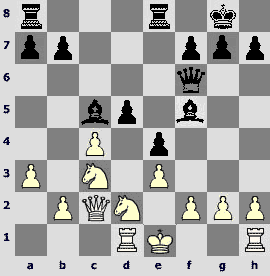
5) How should White continue?
18.¤d2-b3 Ґc5-d6
19.¦d1:d5 ¦e8-e5
In case of 19...Јg6 20.0-0 it is useless to play 20...Ґh3 21.f4!, and in response to 20...Јh6 one should play 21.g3±, unsuccessful would be 21...Ґg4? 22.¤:e4 Ґf3 23.¤bd2 ¦:e4 24.¤:f3 with 2 extra pawns of White (Kholmov).
But 19...Ґe5!? 20.¤d4 Ґ:d4 21.¦:d4 Јg5 also deserved consideration..

6) How should White play?
20.¤b3-d4 ¦a8-c8

7) How should White play?
21.¦d5:e5 Јf6:e5
22.¤d4:f5 Јe5:f5
23.0-0!?
One can explain it psychologically: I was tired of playing with the king in the centre and decided to return the pawn, but I still wanted to finish the development intending to use tactical weaknesses of Black later on – e4, b7, d6-bishop and the 8th rank (Korchnoi).
23.Ј:e4? Ј:e4 24.¤:e4 ¦:c4 25.¤c3 Ґ:a3, and after 23.¤:e4?! b5! 24.0-0 ¦:c4 25.Јd2 Ґc7 was a mistake: the activity of black pieces would considerably compensate his material losses, e.g.: 26.¤g3 Јe6 27.¦d1 g6?.
Korchnoi regarded 23.Јb3!? … 0-0 as deserving attention.
23... . ¦c8:c4
24.¦f1-d1
Worse is 24.Јb3?! Јc8.

8) How should Black defend?
24. . . . Јf5-e5
25.g2-g3 a7-a6

9) How should White continue?
26.Јc2-b3 b7-b5
27.a3-a4 ¦c4-b4
28.Јb3-d5 Јe5:d5
29.¦d1:d5 Ґd6-f8
30.a4:b5 a6-a5!
It is the only possible move. 30...ab 31.¦:b5 is absolutely hopeless.

31.¦d5-d8!?
White could get into the "4 vs. 3 on the same flank" endgame if he continued with 31.b6 ¦:b6 32.¦:a5 ¦:b2 33.¤:e4. Practice proves that the position is most likely to be winning with a rook and a knight against a rook and a bishop. However, Korchnoi still hopes to make more progress having kept the b-pawn. I believe in strength of the passer! (Korchnoi)
31.. . . ¦b4:b2
32.¦d8-a8 f7-f5
In case of 32...¦b3 33.¤d5 f5 (33...g6 34.¦:a5 Ґc5 35.b6! Ґ:b6 36.¦a8+ ўg7 37.¦b8 leads to the loss of a piece) 34.¦:a5 ўf7 35.b6 Ґd6 (35...ўe6 36.¤c7+ ўf6 37.¦b5ќ) 36.¦a7+ ўe6 37.¤c7+ Ґ:c7 38.¦:c7! a lost rook ending arises.
Hopeless is also 32...a4 33.¦:a4 ¦b3 34.¦c4 g6 35.¦c6 (… 36.b6) 35...Ґg7 36.¦c8+ Ґf8 37.g4!
33.¦a8:a5 Ґf8-b4
34.¦a5-a8+ ўg8-f7

10) How should White play?
35.¤c3-a4 ¦b2-b1+
36.ўg1-g2 Ґb4-d6
37.¦a8-a7+ ўf7-f6
38.b5-b6 Ґd6-b8?!
After this move White manages to strengthen his position to maximum: to move a pawn to the 7th rank, to protect it with the c5-knight, to free a rook for active operations along the c- and d-files (Korchnoi).
Kholmov advises 38...h5, in response Timman points out 39.¤c3 ¦b3 40.¤d5+ ўe6 41.¤f4+! Ґ:f4 42.gf g6 (more stubborn 42...ўf6 43.b7 cannot help) 43.b7ќ … ўg3-h4-g5.
It was better to play 38...¦b4, although in this case White could also strengthen his position. One is to move his king on the queen’s flank, another one is to initiate tactical operations with 39.¤c3 (Korchnoi).

39.¦a7-a8
The move 39.¦c7!? suggested by Oscar Panno is tactically correct: 39...Ґ:c7? 40.bc ¦c1 41.¤b6 ¦:c7 42.¤d5+, or 39...¦b4?! 40.¤c5 ¦:b6 41.¤d7+ ўe6 (41...ўg6 42.¦c8ќ) 42.¤f8+! (42.¤:b8 ¦:b8 43.¦:g7 ¦h8 with a threat of 45...ўf6) 42...ўf6 43.¤:h7+ ўg6 44.¤f8+ ўh6 45.¦f7, and White has to win.
However, it is unclear what he can obtain in case of a neutral response 39...h5!? (40.¦c6+ ўe7 41.¤c5 ¦b5).
39. . . . Ґb8-e5
Anatoly Karpov defends from the move of a knight over c3 on d5 leaving the c5-square unprotected. The majority of the annotators have advised 39...Ґd6!?.
Korchnoi made an analysis of 40.¦a6 ўe5 (worse is 40...ўe6?! 41.b7 ўd7 42.¤b6+ ўc7 43.¤c4 Ґe7 44.¤a5 Ґd6 45.¦a8 ўd7 46.¦g8ќ) 41.¦a7. Bad is 41...ўf6?! 42.¦d7 (winning is 42.b7 Ґb8 43.¦a6+ ўe5 44.¤c5 ўd5 45.¦a5 ўc6 46.¤a6 Ґd6 47.b8ЈҐ:b8 48.¤:b8+ ¦:b8 49.¦:f5) 42...Ґe7 43.¤c3ќ. More stubborn is 41...¦b4 42.¤c3 ¦b3 – here the end of the struggle is not completely clear.
Interesting is another way of play as White: 40.¤c3 ¦b3 41.¤d5+ ўe6 (but not 41...ўe5?! 42.¤c7! Ґc5 (42...¦:b6 43.¦a5+) 43.¦a5 ўd6 44.¤e8+ ўc6 45.¤:g7ќ) 42.¤c7+ ўd7 43.¤e8 g6 44.¤:d6 ў:d6 45.¦b8 ўc6.

11) Find the strongest continuation.
12) Evaluate 46.b7 ¦:b7.
13) Evaluate46.b7 ¦b1 47.h4 ¦:b7.
40.¤a4-c5 Ґe5-d6
41.b6-b7 ўf6-e7
42.¦a8-g8 Ґd6-e5
Loosing straight away was 42...ўf7 43.¦d8 or 42...g6 43.¤a6!.
At this moment the game was adjourned.
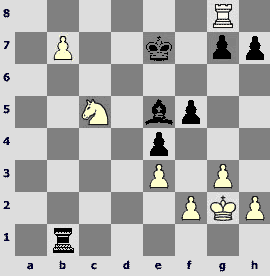
14) White sealed the move. Which one?
43.f2-f4 e4:f3+
44.ўg2:f3 ўe7-f7
45.¦g8-c8
One could have played 45.¦d8 ўe7 46.¦d7+ ўe8 (46...ўf6? 47.¦d5! Ґc7 48.¤a6 ¦:b7 49.¦d7).
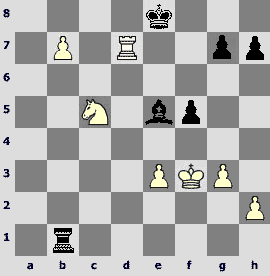
15) Which position should White select?
45. . . . ўf7-e7
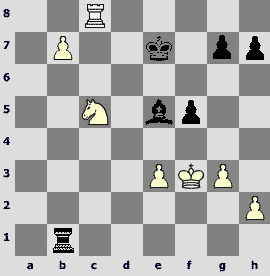
16) How should White continue?
46.h2-h3 h7-h5
In response to 46...g6!? White could answer with 47.g4 (the consequences of 47.¤d3 Ґd6 48.¦h8 h5 49.¤f4 ўf6 50.¦h7± are not quite clear), and bad is 47...¦b5 48.gfgf 49.¤d3 Ґd6 50.¦h8. More stubborn is 47...fg+.
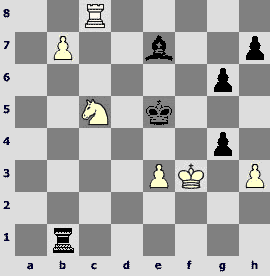
17) How to capture on g4?
Another method of defense was proposed by Ulf Andersson: 46...¦b5!? (preparing Ґd6; in response to an immediate 46...Ґd6? strong is 47.¦g8 ўf7 48.¦d8) 47.g4 fg+ 48.hg Ґd6 49.ўe4 h6 (49...g6? 50.g5!) 50.ўd3 (50.ўf5 ўf7 does not work – also bad is 50...Ґ:c5? 51.b8Ј ¦:b8 52.¦:b8 Ґ:e3 53.ўg6 Ґd4 54.¦g8ќ) 50...¦b4! 51.e4 (51.ўc3 Ґ:c5) 51...Ґe5!.

Black has built an obstacle on the way of the king to the queenside, however, one can surmount it by 52.¦g8! (Zugzwang) 52...ўf7 (52...¦d4+ 53.ўe2! ¦b4 54.¤d3) 53.¦d8 ўe7 54.¦d7+ ўe8 (54...ўf6 55.¦d5 Ґg3 56.¦d4 ¦b1 57.ўc4ќ) 55.¦d5 Ґf6 56.e5 Ґe7 57.¦d4! ¦b5 58.¦a4! Ґ:c5 59.¦a8+ ўf7 60.b8Ј (analysis of Dvoretsky).
47.¦c8-g8 ўe7-f7
48.¦g8-d8 g7-g5
Desperation. (Timman)
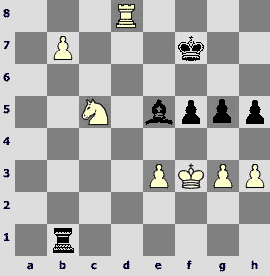
18) How should White continue?
19) Does 49.¤d3 miss a victory?
White could have played 49.¤d7?! g4+ 50.hghg+ (the task of the opponent is easier in case of 50...fg+ 51.ўe4 Ґ:g3 52.b8ЈҐ:b8 53.¦:b8 (… ¤e5+ Kholmov) 53...¦:b8 54.¤:b8 h4 55.¤c6 ўf6 56.ўf4 h3 57.¤e5 g3 58.¤g4+ (Timman) 51.ўe2 ¦b2+ 52.ўd3 Ґ:g3 53.b8ЈҐ:b8 54.¦:b8 (Kholmov).

In response to 54...¦a2 one plays 55.¦b6, e.g.: 55...g3 56.¤e5+ ўg7 57.¦g6+ ўh7 58.¦g5! (58.¦:g3? f4!=) 58...g2 59.¤f3 ўh6 60.¦:f5 ¦f2 61.¦g5 ¦:f3 62.¦:g2ќ. Worth consideration is also 54...¦f2!? 55.¤e5+ ўe6 (55...ўf6? 56.¤:g4+) 56.¦e8+ ўd6, and White has get over technical difficulties, though objectively his position is most likely winning.
Interesting variations appear after 54...¦:b8 55.¤:b8 ўf6 (in reply to 55...g3 easier is 56.ўe2). As Ernesto Inarkiev has mentioned, White has a right to play here 56.ўe2!? ўg5 57.¤d7 f4 58.e4, planning ¤e5-d3, because 58...f3+ 59.ўe3 f2 60.ў:f2 ўf4 61.¤c5! ўe5 62.ўg3 ўd4 63.ў:g4ќ does not work.
The move 56.¤c6 looks more natural.

20) Can Black save himself?
49.g3-g4 h5:g4+
50.h3:g4 ўf7-e7
51.¦d8-g8 f5:g4+
51...ўf7 52.¦c8! fg+ 53.ў:g4 Ґd6 54.e4 Ґf4 55.ўf5 ¦f1 56.¤d7 ўe7 57.e5ќ(Kholmov)
52.ўf3:g4 ўe7-f7
52...Ґd6 53.¤a6ќ
53.¦g8-c8 Ґe5-d6
54.e3-e4
Of course, one cannot play 54.ўf5?? Ґ:c5 55.b8Ј ¦:b8 56.¦:b8 Ґ:e3=.
54. . . . ¦b1-g1+
54...ўf6 55.b8ЈҐ:b8 56.¦:b8 ¦:b8 57.¤d7+ ўe6 58.¤:b8 ўe5 59.ўf3 g4+ 60.ўe3 g3 61.¤c6+ ўd6 62.¤d4ќ (Korchnoi)
55.ўg4-f5 g5-g4

56.e4-e5
In conclusion here there is une petite combination. However, 56.¦d8 would also easily win? As well as 56.b8ЈҐ:b8 57.¦:b8 g3 58.¦b7+.
56... . ¦g1-f1+
57.ўf5-e4 ¦f1-e1+
58.ўe4-d5 ¦e1-d1+
58...Ґ:e5 59.¤d3
59.¤c5-d3! ¦d1:d3+
60.ўd5-c4
Black resigned.
Answers
1.

11.b4? ¤:b4 12.ab Ґ:b4 13.Ґe5 ¤e4 14.¦c1 f6° is a mistake. A quiet 11.¤e5?! does not promise an advantage. One of the strongest moves is 11.¤d2! … 12.b4 – White is not afraid of the opponent's offensive in the center. Timman's commentary is curious:
I think that Russians had a following reasoning during the training: the move 10...¦е8 creates a threat 11...e5 followed by 12...¤d4, therefore it is obvious that White will answer with 11.¤е5. An undoubtedly careful analysis of this move had a possible conclusion that Black has nothing to worry about. Perhaps the move 11.¤d2 was discussed briefly and was rejected for reasons that Korchnoi would feel fast lack of time because of inevitable complications, and in this case the accuracy would not play a big role.
However, Korchnoi shown himself good: there was no time-trouble, but a cool-headed, strong reaction.
2.

Poor is 13.ed? ed+ 14.¤e2 because of 14...¤e4!? (14...¤g4!? 15.Ґh4 dc with a dangerous attack) 15.Ґh4 Ґf5 16.b4 Ј:a3 17.bc d3 18.Јc1 Јa5 19.f3 ¤c3° (Ludek Pachman).
13.Јa4?! Ј:a4 14.¤:a4 ¤c2+! (14...Ґf8? 15.Ґ:f6 gf 16.cdb5 17.¤e4!ќ) 15.ўe2 ¤d4+= leads to a draw.
However, a quiet 13.Јb1! brings Black into difficulties. 14.Ґ:f6 gf 15.¤:d5 is threatening, one always has to take into account knight's capture and a threat to the bishop after b2-b4 (e.g., 13...Ґg4? 14.Ґ:f6 gf 15.¤:d5ќ). On 13...Ґf5 one plays 14.Ґd3.
3.

In the game White played carefully: 15.Ґc2, allowing the opponent to exchange the hanging knight and thereby to make defense easier.
More principled and strong is the move in manner of Wilhelm Steinitz: 15.Ґf1!. White lags in development, but the opponent cannot avoid material losses and establish a sufficient counterplay:
A) 15...¤g4 16.cd! The most convincing – White vacates the c4-square for his pieces and does not permit to retreat the knight. Nevertheless, 16.¤:d5 is also possible. On 16...¤e5?!one does not have to play 17.ed? e3! 18.b4 (18.Ј:f5? ¤f3+! – Ratmir Kholmov) 18...Ј:a3 19.Ј:f5 ed+ 20.ў:d2 Ґ:b4+ 21.¤:b4 Ј:b4+ with attack that would be sufficient at least for a perpetual check, but 17.b4! Јa4 18.bc ¤c2+ 19.ўe2ќ.
16...¤e5
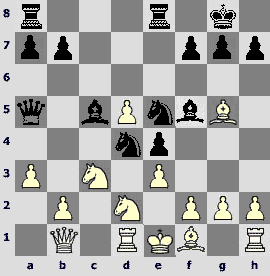
17.¤c4? ¤ef3+ 18.gf ¤:f3+ 19.ўe2 Јa6 20.Јa2 ¤:g5µ;
17.Ґf4 ¤d3+ 18.Ґ:d3 ed 19.0-0 ¤e2+ 20.¤:e2 de 21.Ј:f5› (Sergey Dolmatov);
17.Јc1!? ¤d3+ (17...¦ac8 18.ed Ґ:d4 19.Ґe3) 18.Ґ:d3 ed 19.b4 Јa6 20.bc Јg6 21.0-0! (21.h4!?) 21...¤e2+ 22.¤:e2 de 23.Ґf4 Ґc2 24.¦de1 efЈ+ 25.¦:f1 ¦ac8! 26.Јb2 ¦:c5 27.Ј:b7 Ґe4! 28.¤:e4 Ј:e4= (Korchnoi).
17.ed Ґ:d4 (17...¤f3+? 18.gf ef+ 19.Ґe3 Ґ:b1 20.¤c4 … 21.dc) 18.Ґe3 Ґ:e3 19.fe Јc5. The position of Black seemed promising to Dolmatov, but Timman is probably right asserting that after 20.¤d:e4 Ј:e3+ 21.Ґe2 the attack will be repulsed.
B)15...Ґ:a3 16.Ґ:f6 gf.

Now17.¤:d5? Ґb4! 18.¤:f6+ ўg7 19.¤:e8+ ¦:e8 is mistake (with a threat of ¤b3) 20.b3 Ґg4‚, or 17.ed? e3 18.Ј:f5 ed+ 19.ў:d2 Ґ:b2 20.Јc2 Јb4! 21.h4 (21.Ґd3 dc 22.Ґ:h7+ ўg7) 21...¦e4‚.
17.cd! is right as in a previous variation. And further according to Timman: 17...Ґb4 18.ede3 19.Ј:f5 Ґ:c3 20.bc Ј:c3 21.Јg4+! ўh8 22.fe ¦:e3+ 23.Ґe2 ¦ae8 24.0-0ќ.
Perhaps also possible is 17.Јc1!? Ґb4 18.ed e3 19.fe ¦:e3+ 20.ўf2 Ґ:c3 21.¤b3! (worse is 21.ў:e3 ¦e8+ (21...Ґ:d4+ 22.ў:d4 Јb6+ 23.c5 Јb4+ 24.ўe3 ¦e8+ 25.¤e4!ќ) 22.ўf3 Ґ:d4„ – Dvoretsky) 21...Ґe1+!? (21...Јa2 22.Ј:e3 Ј:b3 (preferable is 22...Ј:b2+ 23.Ґe2 Ј:b3 – Dvoretsky) 23.¦d2!ќ) 22.ў:e3 ¦e8+ 23.ўf3 Ґe4+ 24.ўg4 h5+ 25.ў:h5 Ґg6+ 26.ўg4 ¦e4+ 27.ўf3 Ґh5+ 28.g4 Ґ:g4+ 29.ўg2 Ґ:d1 30.Ј:d1ќ (30.¤:a5? ¦g4+ 31.ўh3 ¦h4+=) – Korchnoi.
Not in vain I have played for three months with the most practical champion in the chess history! I could also learn how to save time and energy. And I have managed to do it! In two minutes I made a Karpov-like move evaluating just general considerations without inquiring into details (Korchnoi).
4.

In case of 16...d4? Black remains a pawn down, having no compensation for it: 17.¤b3 (17.Ґ:f6) 17...d3 18.¤:a5 dc 19.¦c1. Further possible is 19...¤g4 (19...Ґb6 20.¤:b7) 20.¤:b7 Ґf8 21.Ґf4! ¦ab8 (21...¤e5 22.Ґ:e5 ¦:e5 23.b4±) 22.Ґ:b8 ¦:b8 23.¤a5 ¦:b2 24.ўd2± (Korchnoi).
Stronger is 16...Јa6 17.Ґ:f6 Ј:f6, which occurred in the game, however, here Black's compensation for a pawn is also not quite sufficient.
16...dc! 17.Ґ:f6 gf that is proposed by Kholmov establishes a better defense. Poor is the following answer 18.¤:c4?! Јa6 19.¤d5 ¦ac8 20.Јc3 Ґe7µ.
The sharp 18.b4?! cb 19.¤:b3 is also unconvincing: 19...Ј:a3 20.¦a1 (20.¦d5 Ґb4 with a threat ¦ac8) 20...Јb4 21.¦a4 ¦ac8!? (21...Јb6 22.¤d5 Јc6! 23.Ј:c5 Ј:a4 24.¤:f6+ ўg7=) 22.¦:b4 Ґ:b4 23.0-0 Ґ:c3µ.
According to Timman, White preserves the advantage by 18.0-0!. Indeed, bad is 18...b5? 19.b4!ќ, or 18...ўg7? 19.b4! (19.¤:c4 mentioned by Timman does not promise a lot because of 19...Јa6 20.¦d5 ¦ac8 21.¦:f5 Ј:c4) 19...cb 20.¤:b3 Ј:a3 21.¦a1 Јb4 22.¤d5ќ.
However, Black is successfully defending by 18...Јa6! 19.¤d5 ¦ac8 20.Ј:c4 Јe6.

According to Korchnoi, after 21.¤f4 White has nevertheless a better position. Even if is so, his advantage is not big (21...Ј:c4 22.¤:c4 ¦ed8?).
Perhaps, the continuation selected by Karpov is objectively weaker than the aforementioned one, but one should not forget that I also have taught Karpov something during those three months – to avoid irreparable pawn weaknesses (Korchnoi).
5.

In case of 18.¤:d5?! Јg5 19.0-0 Black does not choose 19...Ґh3? 20.¤f4 or suggested by Kholmov 19...Ґg4? because of 20.¤:e4! Ґ:d1 21.¦:d1 Јg6 22.f3± (22.¤c7!?), but 19...Ґd6!„ (with a threat of 20...Ґh3), keeping a not bad compensation for a lost pawn.
Much stronger is 18.¤b3!, with idea to take on d5 by the knight and not by the rook.
6.

Mikhail Tal rewards the move 22.ўf1?! with an exclamation mark, but in fact it is not as good – after 22...¦ad8 Black receives excellent counterplay in all the variations: 23.¤d5 Ґe6›; 23.¤e2 Ґg4 24.¦:d8 Ґ:e2+! 25.Ј:e2 (25.ў:e2 Јg4+!) 25...¦:d8 26.g3 ¦d3 27.ўg2 Јf5© 28.¦d1?? Јf3+; 23.¦:d8!? ¦:d8 24.¤e2 ¦d3©.
Ulf Andersson gives a better advice 22.g3!? … ўd2-c1.After 22...¦ad8 23.¤e2 Ґg4 24.¦:d8 (24.0-0!?) 24...¦:d8 25.¤d4 Timman evaluates this position in favor of White. However, this appraisal is disputable in view of 25...Јa5+ 26.Јd2 Јa4›.
The strongest move 22.0-0! allows White to keep the advantage. For example, 22...Ґh3 23.f4 ef 24.¦:f3±, and 24...¦:e3 25.Јd2! ¦e1+ 26.ўf2 Ј:g2+ 27.ў:e1 ¦e8+ 28.¦e4ќ does not work.
7.
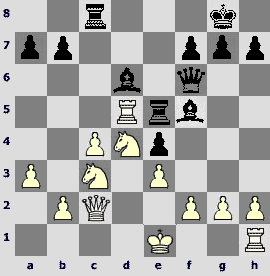
In the variation that was mentioned by Korchnoi (21.¤:f5?! ¦:d5 22.¤:d5 Ј:f5 23.Јb3 Јe5 24.g3 (24.a4!?) 24...b5! 25.Ј:b5 ¦b8 26.Јd7 Ј:b2! 27.0-0 Ј:a3) White "was almost losing all his advantage".
The move f2-f4! consolidates White's advantage. One could play it straight away: 21.f4!? ¦:d5 (21...ef? 22.¤:f5 fg 23.¦g1ќ) 22.¤:d5 Јh4+ (in response to 22...Јg6 strong are both 23.0-0 and 23.¤:f5 Ј:f5 24.Јa4) 23.g3 Јh5 24.0-0 (weaker is 24.¤:f5 Ј:f5 (with a threat of 25...Ј:d5) 25.Јb3 Јh3©) 24...Ґh3 25.¦c1±.
But it would be stronger to play f2-f4! one move later, having exchanged the rooks previously: 21.¦:e5! Ј:e5 (21...Ґ:e5? 22.¤d5ќ) 22.f4! Јf6 (22...ef? 23.¤:f5 fg 24.¦g1ќ), and now at least 23.¤:e4!? Ґ:e4 (23...Јg6 24.¤f6+ Ј:f6 25.Ј:f5ќ) 24.Ј:e4 ¦:c4 25.0-0 with a big advantage.
The continuation in the game is less convincing.
8.

As Korchnoi noted, the best defense would have been 24...Ґf8! 25.¦d8 (25.¦d4?! ¦:d4 26.ed Јg5 27.¤:e4 Јd5 28.Јd3 Јa2) 25...g6 26.Јd1 ўg7 27.h3?.
Tal recommends 24...Ґe7, however, after 25.¦d4! ¦:d4 26.ed Black can't play 26...Ґf6 (Larsen) in view of 27.¤:e4 Ґ:d4? 28.¤f6+! (Kholmov).
On 26...Јg5 Tal considers only 27.¤:e4 Јd5 28.Јd3 Јa2„. Instead of 28.Јd3?! interesting is 28.Јa4?! anticipating 28...Ј:e4?? 29.Јe8+ or 28...b5? 29.¤c3±. Not good is 28...Јa2? 29.Јe8+! (worse is 29.h3?! Ј:b2 30.Јe8+ Ґf8 31.d5 Јc1+ 32.ўh2 Јf4+ 33.g3 Јf3 threatening 34...f5) 29...Ґf8 30.g3 Ј:b2?! 31.d5ќ. However, one finds a saving counterblow 28...Ґ:a3!›.
Korchnoi shows the best continuation: 28.¤g3! Ј:d4 (more stubborn is 28...g6± – Dvoretsky) 29.¤f5 Јe5 30.¤:e7+ Ј:e7 31.Јc8+ Јf8 32.Ј:b7ќ.
Kholmov suggested another excellent idea in response to 26...Јg5: 27.g3!, and if 27...e3 (27...f5 28.¤d5), then 28.f4! Јg4 29.Јe4ќ.
9.

It is time to arrange the attack on black pawns by means of 26.Јb3! b5 (26...¦c7 27.¤:e4 or 27.Јd5) 27.a4!, e.g.: 27...¦c5 28.abab 29.¦d4±, или 27...¦b4 28.Јd5±.
10.

In case of 35.¤d5?! one had to reckon on the attack on the f2-pawn by 35...Ґe1. Premature is 36.b6? ўe6, therefore, White answers 36.ўf1.
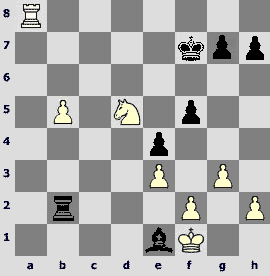
Now 36...¦:b5? is bad because of 37.¦a7+ ўf8 38.¤c7 ¦b1 39.¤e6+.
The move 36...Ґ:f2 with an idea to give a bishop for the b-passer and one of the pawns from the queenside is suggesting itself – arising ending with 4 pawns against knight and 2 pawns can end in a draw. In response to 37.b6 there is an immediate 37...Ґ:e3!? 38.¤:e3 ¦:b6, however, the position after 39.¦a7+ ўg6 looks uneasy, it is not unconceivable that it is lost. Even 37...g6 cannot solve the problems of Black, bearing in mind a variation 38.b7 Ґ:g3 39.hg ¦:b7 with probable draw. White can play 38.¦c8!, e.g.: 38...ўe6 (38...Ґ:e3 39.¦c7+ ўg8 40.b7ќ; 38...h5 39.¦c6 h4 40.g4!) 39.¤f4+ ўd7 40.¦c7+ ўd6 41.¤g2 ¦:b6 42.¦:h7 ¦b2 43.¦h6ќ (this analysis was carried out together with grandmaster Vadim Zvjaginsev ).
Nevertheless these variations are quite difficult for a practical game. Besides the capture on f2 is not obligatory – the move 36...¦b1! is strengthening the play of Black. In case of 37.ўe2, one answers with 37...g5!, preparing 38...ўe6. Unconvincing is also 37.¦a7+ ўe6 38.¤c7+ (38.¤f4+ ўd6 – 39...g5 is threatening, and the g7-pawn is invulnrable) 38...ўd7 39.ўe2 g5.
In the game White chose 35.¤ to drive away the rook from the b-file or from the 2nd rank. The defect of this move is the knight on the edge of the board. After 35...¦b1+ 36.ўg2 Ґd6 37.¦a7+ ўf6! Black is still able to offer resistance
An intermediate check 35.¦a7+! is the most dangerous. Bad is 35...ўf6? because of 36.¤d5+ ўg6 (36...ўe5 37.¤:b4 ¦:b4 38.¦:g7) 37.b6 Ґe1 38.b7ќ. But in case of 35...ўe6 or 35...ўg6 the move 36.¤a4 is better in comparison with the game.
11.

White immediately blows up a pawn chain of the opponent and gains a great advantage in the rook ending: 46.g4! fg 47.ўg3.
а) 47...¦b5 48.ў:g4 (48.¦f8 ўd5!) 48...¦f5 49.ўg3 ¦f3+ 50.ўg2 ¦f7 51.¦c8+ (51.¦e8 ўd5!?) 51...ў:b6 52.¦e8±;
b) 47...¦b2 48.b7!(far weaker is 48.¦h8? ¦:b6 49.¦:h7 ўd5 50.ў:g4 (50.¦f7 ¦b1! 51.ў:g4 ¦g1+) 50...¦f6 51.¦d7+ ўe6 52.¦d2 ¦f5 with a probable draw) 48...¦b5 (Hopeless is 48...h5 49.¦g8 ў:b7 50.¦:g6 ўc7 51.¦e6 or 50...h4+ 51.ўg2) 49.ў:g4 ¦f5 50.ўg3 (50.¦h8?! ў:b7 51.¦:h7+ ўc6; 50.¦e8?! ў:b7 51.¦:e4 ¦:f2 52.¦e7+ ўc6 53.¦:h7 ўd5) 50...¦f3+ 51.ўg2 ¦f7 52.¦e8 (or 52.¦c8+ ў:b7 53.¦e8), and there comes a position with a good chances for a win to White, almost as in the previous variation.
Other plans promise less to White. For instance, 46.¦h8? ¦:b6 47.¦:h7 ўd5 48.¦h6 ўe5 49.h4 ўf6 (49...¦e6) 50.h5 ўg7 51.¦:g6+ ¦:g6 52.hg ў:g6 leads to a drawish pawn ending.
Timman recommends 46.h4. After 46...¦b1? 47.¦h8 ¦:b6 48.¦:h7 an extra tempo of White in comparison to the previous variation is decisive 48...ўd5 49.¦h6 (49.h5!? ¦e6) 49...¦e6 (50.h5 was threatening) 50.h5 gh 51.¦:h5 ¦e5 52.g4 fg (52...ўe6 53.¦:f5 ¦:f5 54.gf+ ў:f5 55.ўh3!) 53.¦:e5+ ў:e5 54.ўg3 ўf5 55.ўh4ќ. Timman considers a pawn ending that arises in case of 46...¦:b6 47.¦:b6+ ў:b6 48.g4 to be won. Whether this is true or not will become clear after the answer to the 13th question is given.
In case of 46.b7?! quite a good reply is 46...¦b6 with the idea to meet 47.h4 by 47...h5 and in case of 48.¦g8 ў:b7 g6 pawn is protected. If 47.g4, then 47...fg 48.¦e8 (48.ўg3 h5 49.¦g8 ў:b7) 48...ў:b7 49.¦:e4 h5?.
Read two next questions about other reactions to 46.b7
12.
46.b7 ¦:b7? 47.¦:b7 ў:b7 loses.

48.g4 fg (48...ўc6 49.gfgf 50.ўg3 ўd5 51.ўf4 ўe6 52.ўg5ќ) 49.ўg3 ўc6 50.ў:g4 ўd5 51.ўf4 (impossible is 51.ўg5? ўc4) 51...ўd5 52.h3! (52.h4? h6 is a mistake, and White is in zugzwang) 52...h6 53.h4 (Black is in zugzwang) 53...h5 54.ўg5ќ.
13.
After 46.b7 ¦b1!? (46...¦b6!?) 47.h4 there is either the threat of 48.h5 or 48.g4. However, in such a situation Black has a right to transit into the pawn ending: 47...¦:b7! 48.¦:b7 ў:b7 49.g4 fg 50.ўg3 ўc6.
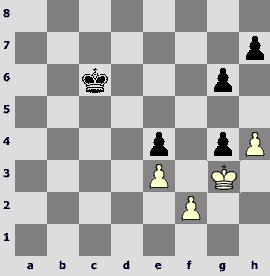
а) 51.ў:g4 h6! 52.h5 g5 53.ўf5 ўd5 54.ўg6 ўe6 55.ў:h6 ўf6 56.ўh7 ўf7 57.h6 g4=;
b) 51.ўf4 ўd5 52.ў:g4 ўc4! A counter-attack against f2 pawn redeems the position of Black: 53.ўg5 ўd3 54.ўh6 ўe2, and it is certain that pawns queen simultaneously.
It should be noted that a move 52...ўc4! (that was probably missed by Timman in his analysis of the variation 46.h4 ¦:b6) – is the only way to a draw. After 52...h6? 53.ўf4 Black is in zugzwang.
52...ўe5? is also a mistake

White plays 53.h5! gh+ 54.ў:h5 ўf5 55.ўh4 instead of 53.ўg5? ўd5 (an interesting position of the reciprocal zugzwang) 54.ўh6 (54.h5 gh 55.ў:h5 ўc4=) 54...ўe6 55.ў:h7 ўf7 56.ўh6 ўf6 57.h5 g5 58.ўh7 ўf7 59.h6 g4 and because of the zugzwang will get one of the opponent's pawns.
Finally, in case of 52...ўc5? White gets a before mentioned position of the reciprocal zugzwang responding to the opponent's move with 53.ўf4! (but not 53.ўg5? ўd5!) 53...ўd5 54.ўg5 ўe5 (54...ўc4 55.ўh6ќ) 55.h5ќ.
14.

The capture on f3 is forced after 43.f4!, and white king enters the play.
15.

A chase of f5 pawn does not promise much to White: 47.¦d5 Ґb8 48.¦:f5? Ґd6! 49.¤e4 Ґe7, and after the inevitable capture on b7 Black has a defendable position . By the way, Korchnoi suggests 48...Ґa7? (unlike me – with an exclamation mark), However, White wins by force in this case playing 49.¦e5+! ўf7 50.¤e6 ўf6 51.¦a5 ¦:b7 (51...Ґ:e3 52.¦a6) 52.¤d8 ¦e7 (52...¦d7 53.¦a6+ ўg5 54.¤c6ќ) 53.¦a6+ ўg5 54.¤e6+ ўf5 55.e4+ ўe5 56.¤d8!ќ.
Much stronger is 47.e4!, that is responded with 47...¦b5.
One of Korchnoi's coaches, grandmaster Raymond Kin reported in his book about the match that their team was analyzing 48.ef ¦:c5 49.¦:g7, but they could not find a clear win in case of 49...h6!.
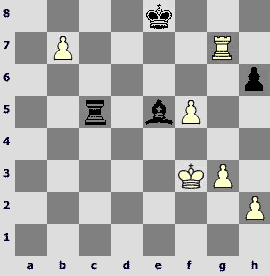
I think White wins after 50.f6!. Here are some exemplary variations:
50...Ґd6 51.f7+ ўf8 (51...ўe7 52.¦g6 Ґc7 53.¦f6 ўf8 54.¦:h6ќ … 55.¦h8+) 52.¦g6 Ґe5 (52...Ґc7 53.¦:h6) 53.¦e6 ¦b5 54.¦:e5 ¦:b7 55.¦f5ќ;
50...ўf8 51.¦e7 Ґd6 52.¦d7 Ґe5 53.ўe4 ¦b5 54.ўf5! Ґc7+ 55.ўg6 ¦:b7 56.¦h7 ўe8 57.ў:h6ќ.
Timman indicated another way to the goal: 48.¦d5! fe+ (48...Ґb8 49.ef Ґa7 50.f6! gf 51.¤e4 ¦b3+ 52.ўg2! ўe7 53.¦h5ќ) 49.ў:e4 Ґb8 50.ўd3 (50.ўd4) 50...Ґa7 51.ўc4 ¦b6 (51...¦b2 52.¤b3ќ)

52.¤e4! Ґb8 53.¦b5.
The analysis can probably be interrupted here. Timman also suggests 53...¦e6 54.¤c5 ¦e2 55.¤a6 Ґa7 56.b8Ј+ Ґ:b8 57.¦:b8+ ўf7 58.h3! (58.h4? ¦e3 59.¦b3 ¦:b3 60.ў:b3 ўg6=) 58...¦h2 59.h4ќ.
16.

46.e4 suggests itself, leading to the ending with extra exchange to White almost by force: 46...fe+ 47.ў:e4 Ґd6 48.ўd5 Ґ:c5 (48...¦b5? 49.¦e8+! ў:e8 50.ў:d6ќ) 49.b8Ј ¦:b8 50.¦:b8.

Black has some chances to put up one of the theoretical drawish positions (with the pawns on h5 and g6 and a bishop either on the longest diagonal or on h4 when the white pawns are on h3 and g4). However, this is not an easy thing to do, mainly because the bishop does no have an access neither on h4, nor to the longest diagonal. For instance, after 50...Ґg1 51.h3 it's impossible to play 51...h5? 52.¦h8 g6 53.ўe5ќ (with subsequent 54.¦h7+), and to 51...Ґf2? there is a strong response 52.¦b2!, and g3 pawn is invincible due to 53.¦g2. Black has to play 51...ўf7 (Timman), in this case it also causes some problems to get a draw.
However, in this situation the win is not guarantied to White as well (the position requires an additional detailed analysis), that's why Korchnoi is right having chosen another way.
46.h3! this sly move slipped Soviet aces attention (Korchnoi). White prepares g3-g4 to get the e-passer and e4 for the king, having provoked an exchange on g4.
Karpov's response was not very good: 46...h5?!, having weakened the pawns of the kingside. 47.¦g8 ўf7 48.¦d8 was to follow, this weakening would tell in case of 48...ўe7 – now there is an easy win 49.¦d7+ ўe8 (49...ўf6 50.¦d5 Ґb8 (50...Ґc7 51.¤a6! ¦:b7 52.¦d7ќ) 51.¦d8 Ґc7 52.b8Ј) 50.¦d5 Ґb8 51.¦:f5 Ґd6 52.¤e4 ( h5 pawn is under a blow).
However the position of Black was still lost under other methods of defense.
17.

As Bent Larsen noted, White should play 48.ў:g4! with a subsequent return of the king to the center. In this case the creation of a passer on the kingside will require serious efforts and certainly will be late.
It's more difficult to prove a win after 48.hg h5 49.gh gh 50.ўe4 Ґg3!. Leads only to a draw 51.ўd5 h4 52.e4? (better was 52.¦h8, however after 52...ўf6 53.e4 ўg7 54.¦a8 ¦d1+ the result of the struggle is unclear) 52...h3 53.e5 h2 54.¦c7+ ўf8 55.¦h7 ўg8 56.¦h3 ўf7 57.e6+ ўe7 58.¦h7+ ўe8 59.¤e4 ¦:b7 60.¦h8+ ўe7 61.¤:g3 ¦b5+. Stronger is 51.¦h8 h4, and now 52.ўf3 instead of 52.¤a6? ўf6 53.b8ЈҐ:b8 54.¦:b8 ¦:b8 55.¤:b8 h3 56.ўf3 h2 57.ўg2 ўe5 with a draw, and 52.ўf3, keeping good chances for a win.
18.
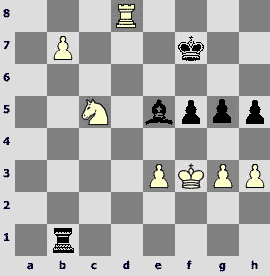
The easiest and the most convincing is 49.g4!ќ. Black does not have time for 49...fg+ 50.hgh4 because of 51.¤d7 ўe7 52.b8ЈҐ:b8 53.¦:b8ќ.
There are other ways to reach the goal, but they are hanging by a thread, far and precise calculation is required of White.
19.
To 49.¤d3?! follows 49...g4+.

Only to a draw leads a mechanical 50.hg? hg+ 51.ўf2 ўe7! 52.¤:e5 ў:d8 53.b8Ј+ ¦:b8 54.¤c6+ ўc7 55.¤:b8 ў:b8 56.e4 ўc7! 57.ef ўd6= (Тal). Not very convincing is 52.¦d5!? Ґd6 53.¦:f5 ¦:b7 54.¦g5 ¦b3 55.¤f4 ¦b2+.
50.ўg2!! ўe7 51.¦d5 Ґd6 52.¦:f5 gh+ 53.ў:h3 ¦:b7 54.¦:h5 should be played with two extra pawns.
20.

Hopeless is 56...ўg5 57.¤d4 g3 58.ўe2 ўg4 59.ўf1 (Timman).
It's more difficult to refute 56...g3!?. After the forced 57.¤d4 (57.ўe2? g2 58.ўf2 f4 59.ef ўf5=) 57...g2 58.¤f3 ўe6 White finds the only unobvious way to the goal.

The win is missed either by 59.ўe2? ўd5 60.ўf2 ўe4 or 59.ўd4? ўd6 60.¤g1 ўe6 61.¤h3 ўd6 (the position of the reciprocal zugzwang).
The goal is reached only in case of 59.ўc4!! ўd6 60.ўd4 ўe6 61.¤g1! ўf6 62.¤h3! (impossible is 62.¤e2? ўg5=), and Black is in zugzwang (62...ўe6 63.¤f4+).
